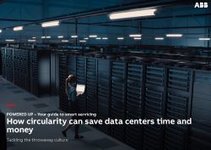The climate crisis agenda is placing all businesses under pressure to prove their sustainability credentials for every activity.
Banks are looking for climate impact reports and policies before lending. Investors are seeking viable data to measure the value of ESG actions, with a particular focus on verifiable strategies that tackle climate change and cut carbon emissions.
The amount of information being sought will be huge. It will span everything from financial reporting to providing valid data on how each and every operation sources energy and uses electricity.
For example, the International Financial Reporting Standards Foundation has set up an International Sustainability Standards Board to develop global sustainability reporting standards. Blackrock, the world’s largest asset manager says on its homepage: “Our investment conviction is that climate risk is investment risk, and that integrating climate and sustainability considerations into investment processes can help investors build more resilient portfolios and achieve better long-term, risk-adjusted returns. We believe that society is on the cusp of a transformational change towards sustainability.”
Businesses are being warned to step up. Large companies are hiring or promoting individuals to the role of Chief Sustainability Officer. It’s a big job.
Writing in Forbes recently, Oracle’s CSO pointed to technology innovations as holding some of the answers to achieving net zero. Whether it’s through more efficient light bulbs, using AI tracking and reduce power use across vast built environments or developing tools that help firms comply with climate regs, technology is vital.
Data centers don’t stand alone
For businesspeople outside the data center industry, all they know is their data lives in the cloud and they want that cloud to be carbon neutral.
They demand that none of their data, including the sustainability data that will be used to inform decision making, is stored in carbon spewing, energy wasting data centers.
For users and customers, the information (data) on where, how, and how much power is consumed inside the data center is suddenly becoming important
For those inside the data center business, as we begin the journey to become carbon net zero, this presents big challenges.
We are currently just another business sector reacting to price and supply volatility in the energy markets and looking for solutions. Yet in the short to medium term, the data center sector may fast become an integrated part of the energy supply chain.
Some data center operators are reacting quickly to the carbon issue and citing grid integration as a USP. Today, firms like Lancium.com are providing valuable data on grid power system integration. Lancium says it is building data centers in Texas that will act as ‘controllable load resources,’ where ‘the net effect on the electrical system is carbon negative.’
Can technology help data centers reach net zero?
So, where to start? Delivering power to the workload for secure uptime remains the critical role of a data center. Ordinarily, the infrastructure used to ensure the design purpose is met is fixed, inflexible and wasteful. Adaptability, while clearly and increasingly desirable, has been elusive to date.
New power topologies must be flexib le, and overcome the challenges associated with fixed systems and address waste and stranded capacity while still ensuring availability. They must be available for existing data centers and newly built ones. i3's proposal for this is Adaptable Redundant Power (ARP).
Data centers will be sustainable. Data center developers seeking investment (and permission) to build the vast campuses to run the 21st century digital economy will need to demonstrate policies that address climate change.
Whatever we build in the future or change in existing data centers is going to be measured against sustainability credentials. The climate crisis demands long term solutions and as we plan for 2030 only those that stand up to scrutiny will be accepted.





